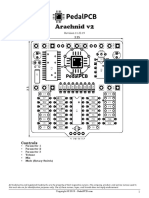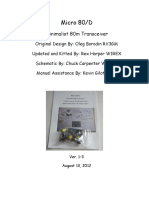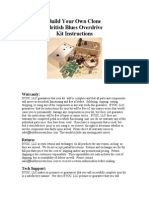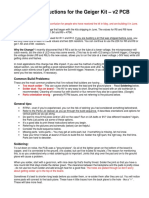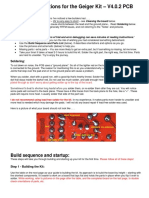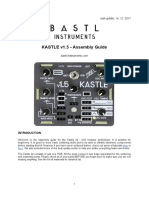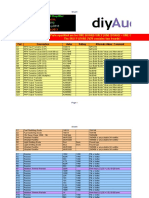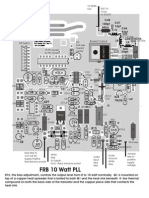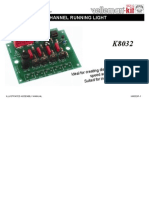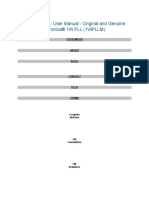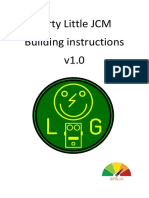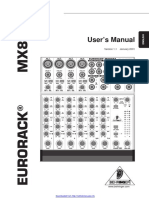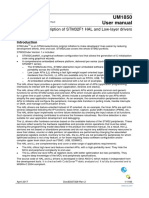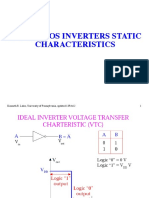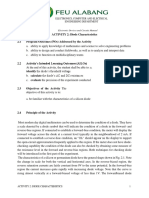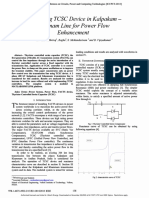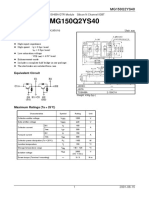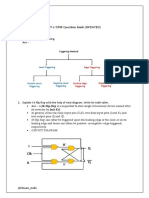Have Mercy
Building instructions
v1.2
� Have Mercy v1.2
Table of contents
PCB layout ............................................................................................................................................... 3
Components ............................................................................................................................................ 4
Power section .......................................................................................................................................... 5
Build sequence ........................................................................................................................................ 5
Calibration ............................................................................................................................................... 6
Off board wiring ...................................................................................................................................... 6
Potentiometers.................................................................................................................................... 6
Switches............................................................................................................................................... 8
Modifications........................................................................................................................................... 9
Transistors ........................................................................................................................................... 9
Op amp and charge pump ................................................................................................................... 9
Clipping section ................................................................................................................................... 9
Pot values and resistors....................................................................................................................... 9
Hissing and squealing .......................................................................................................................... 9
Extra noise and pop protection in boost section .............................................................................. 10
Change gain switch to potentiometer ............................................................................................... 10
Conversion ......................................................................................................................................... 10
SHO™ ............................................................................................................................................. 10
Box of Rock™ ................................................................................................................................. 10
Troubleshooting .................................................................................................................................... 11
Schematic .............................................................................................................................................. 12
Changelog v1.2 vs v1.1:
- Minor orientation changes to parts
- Minor PCB layout optimizations
Read this entire manual thoroughly before you start building the effect! There are some available
options and you should choose which one you want to incorporate before starting your build.
Last update: 18-02-2019
Manufacturers and product names are mentioned solely for circuit identification, and where applicable their trademarks are the
property of their respective owners who are in no way associated or affiliated with the author. No cooperation or endorsement
is implied.
2
� Have Mercy v1.2
PCB layout
Dimensions: 50 mm x 100 mm
1.97 inch x 3.94 inch
Manufacturers and product names are mentioned solely for circuit identification, and where applicable their trademarks are the
property of their respective owners who are in no way associated or affiliated with the author. No cooperation or endorsement
is implied.
3
� Have Mercy v1.2
Components
Name Value Comment Name Value Comment Name Value
C1 100n SMF D1 LED Red 5mm R1 68k
C2 100p MLCC D2 LED Red 5mm R2 2M2
C3 33u Electrolytic D3 1N270 Germanium R3 8M2
C4 100n SMF D4 1N270 Germanium R4 47k
C5 100u Electrolytic D5 Zener 10V 1W R5 1k
C6 100n MKT D6 Zener 10V 1W R6 10k
C7 22p MLCC D7 Zener 10V 1W R7 15k
C8 100n SMF D8 1N5817 R8 10k
C9 33u Electrolytic D9 Zener 12V 1W R9 47R
C10 470n SMF D10 1N5817 R10 2M2
C11 47u Electrolytic D11 1N5817 R11 2M2
C12 470n SMF R12 3k3
C13 100n SMF IC1 OPA132 R13 47R
C14 47n SMF IC2 LT1054 R14 390R
C15 22n SMF IC3 LT1054/ICL7660S R15 1M
C16 22n SMF R16 1M
C17 150p MLCC P1 B25k Gain R17 5k1
C18 470p MLCC P2 B1k Channel Blend R18 100R
C19 22n SMF P3 B100k Tone R19 1k
C20 22n SMF P4 A100k Volume R20 100R
C21 1u SMF P5 C25k Boost R21 470k
C22 10n SMF R22 22k
C23 22n SMF Q1 2N5088 R23 1M
C24 2n2 SMF Q2 2N7000 R24 1M
C25 2n2 SMF Q3 2N7000 R25 5k1
C26 100n SMF Q4 BS170P R26 47R
C27* 100u Electrolytic Q5 BS170P R27 1M
C28* 100n MKT Q6 BS170P R28 1M
C29 10u Electrolytic Q7 BS170P R29 5k1
C30 4u7 Electrolytic R30 330R
C31 100u Electrolytic SW1 DP3T (ON-Z-ON) Structure R31 47k
C32 100n MKT SW2 SP3T (ON-OFF-ON) Gain R32 82k
C33 10u Electrolytic SW3 SPDT (ON-OFF) Presence R33 10k
C34 10u Electrolytic SW4 SPDT (ON-ON) Voltage R34 10k
C35 47u Electrolytic R35 1M
C36 100n MKT VR1 B10k Set 5k R36* 10k
C37 47u Electrolytic VR2 B5k Set 0k R37 1M
C38 100n MKT R38 1M
C39* 22u Electrolytic R39 5k1
R40 5k1
R41 100k
* Optional parts.
All parts need to be 25V+ rated A=Log, B=Lin, C=Rev. Log
Manufacturers and product names are mentioned solely for circuit identification, and where applicable their trademarks are the
property of their respective owners who are in no way associated or affiliated with the author. No cooperation or endorsement
is implied.
4
� Have Mercy v1.2
Power section
IC3 can be either a LT1054 or a (cheaper) ICL7660S. If you want to use the 7660S then you’ll need to
connect both pads of J1
I do not advise to use a battery in this build as the charge pumps will do strange things when the
battery is depleting. This is why it is also left out in the off board wiring section.
Build sequence
Soldering this board can be very complicated for some people since the solder pads are very close
together. Use a magnifying glass to make the job easier.
The trick to soldering a PCB is to work from small to big components. My building sequence
suggestions in this section are based on the parts I used myself. Sometimes some components are
smaller (or bigger) so always use your own common sense and change the order accordingly. Usually
capacitors can differ a lot in size depending on their rating and value.
Note: Do not blow on your solder in an attempt to cool it down. That can result in a bad join that
might corrode! Also take extra care not to short components.
Start by soldering the resistors and jumpers (if needed). If needed you can create a jumper using a
spare piece of lead from a resistor or diode. Next come the diodes (not the LEDs).
If you want to experiment with other transistors then you could socket them instead of soldering
them to the board. You’ll need a some 20 SIL sockets, break off the sockets and solder them to the
board. Now is the time to solder these sockets on the PCB as well as the socket for the IC. Place the
transistors and IC once you are finished with all soldering and off board wiring!
Now continue by soldering the SMF and MKT capacitors then solder the internal trimpots (VR). Now
finish with soldering the transistors (if not socketed), LEDs and the Electrolytics.
I suggest you now drill the holes in your enclosure so you can use it during the off board wiring.
Note: Really take some time to determine where to place the pots, switches, jacks and PCB in the
enclosure before you start drilling. Measure twice, drill once.
You are almost ready to rock, well… not really. The difficult part starts now.
Manufacturers and product names are mentioned solely for circuit identification, and where applicable their trademarks are the
property of their respective owners who are in no way associated or affiliated with the author. No cooperation or endorsement
is implied.
5
� Have Mercy v1.2
Besides the components mentioned in the components table, you will need:
• 3 mono input jacks. 2 x 3PDT footswitch (9 pins)
• 2,1mm DC jack (isolated).
• 22 gage stranded hook-up wire.
• 2 x LED holders. This enables you to mount the LEDs in the enclosure.
• 2 x LED (3mm or 5mm depending on your taste). These are the status LEDs
• Hammond 1590BB case (or similar) in your favorite color. This case will fit very(!!) tight and
leaves no room for error. If you need more room you could consider using a Hammond
1590XX.
Calibration
Once everything is connected, you should calibrate VR1 and VR2 to give you your optimum gain.
Start by setting VR1 to 12 o’clock (50%) and VR2 all the way to the left (0%). Set P1 (Gain) to about 2
o’clock (70%), the gain switch SW2 in the middle position (low gain) and the voltage switch SW4 to
9V. This should give you a nice crunch sound. Now test setting P1 (Gain) to max and try all settings on
the gain switch SW2 to see if you like all positions. If not, you can add more gain by turning VR1 to
the right, or subtract gain by turning VR1 to the left. You can also lower the gain by turning VR2 to
the left. Please note that VR1 and VR2 communicate. Changing one will affect the function of the
other.
Off board wiring
Potentiometers
In the pictures below you see the correct pin numbering of the pots (Alpha 16mm style).
Solder the wires accordingly and it is always a good idea to twist the wires together to create some
extra shielding against external noise. The rectangle pad marks the pad for pin 1.
You can break off the pin I marked with the yellow circle with a small pair of pliers.
Gain Channel Blend Tone
3 2 1 3 2 1 1 2 3
Volume Boost
1 2 3 3 2 1
The wiring for the switches is the same, marking position 1 with a rectangle pad.
Manufacturers and product names are mentioned solely for circuit identification, and where applicable their trademarks are the
property of their respective owners who are in no way associated or affiliated with the author. No cooperation or endorsement
is implied.
6
� Have Mercy v1.2
Note that R led1 and R led2 are 4k7 resistors. You can change these values depending on the type of
LED you use but 4k7 is safe enough for almost all LEDs @9V.
Manufacturers and product names are mentioned solely for circuit identification, and where applicable their trademarks are the
property of their respective owners who are in no way associated or affiliated with the author. No cooperation or endorsement
is implied.
7
� Have Mercy v1.2
Switches
4 5 6
3 2 1
Manufacturers and product names are mentioned solely for circuit identification, and where applicable their trademarks are the
property of their respective owners who are in no way associated or affiliated with the author. No cooperation or endorsement
is implied.
8
� Have Mercy v1.2
Modifications
Transistors
Q4 to Q7 are based on the BS170P as used in a lot of Zvex pedals. You can of course use the regular
BS170 instead of BS170P but note that the pinout is different! Soundwise they are exactly the same.
Op amp and charge pump
You could use a OPA134 instead of the OPA132. It is available in DIP8 and is often cheaper while it
makes no audible tonal difference. Note that TI does not make OPA132 in DIP8 so if you find them on
Ebay or AliExpress, they are fake! If you come to think of it, you could use almost any pin compatible
single op amp chip although I can’t guarantee there will not be tonal differences and it must be able
to take -9V (Vcc-) and +9V (Vcc+). You could also buy a OPA132 (SMD) and a converter board to keep
true to the original.
Clipping section
Diode section can be wired in a lot of different ways. Note that the designated pins of a ON-Z-ON are
marked on the PCB and correspond to the following switches depicted in the middle position (so do
not think you need to wire pin 2 to 3 and 6 to 5) :
4 5 6
Or:
6 5 4
(depending on the
type of switch)
3 2 1 1 2 3
You can connect pin 2 and 5 together on the switch and then connect one of those pins with a wire
to the pad marked 25. The rest is straight forward. Pin 1 to the pad marked 1, pin 4 to the pad
marked 4 and pin 6 to the pad marked 6 (pin 3 is not connected). You can always connect it another
way if you want different options or use different diodes/transistors, just remember that the pad
marked 25 is for the common pins (middle pins) of the switch. Remember to check the forwarding
voltages of the clipping components when making your choice.
Pot values and resistors
The Gain pot (P1) is reportedly better off using a A50k instead of a B25k. Same goes for Channel
Blend (P2) using a C1k instead of a B1k. An A25K for Boost (P5) is also ok.
It is also reported that leaving out R10 will do the gain some good.
Hissing and squealing
As this is a very high gain effect, using the gain switch will introduce some extra hissing and possibly
squealing. For this I added an optional filter capacitor C39 and it is reported that using a 22uF in
there will lessen the squealing. If you do not use it then place a jumper in C39! For this I also added
VR1 and VR2. With those trim pots you can lower the gain on both stages. The original only uses a
5k1 in R18 and R26 is a 47R. If you want to use it as in the original then leave out VR1 and VR2 and
use a jumper between pad 1 and 2 of both VR1 and VR2. Else set both VR1 and VR2 to 5k. Another
option is to replace R20 with a 330R or 470R. A little less high gain but also less squealing.
Manufacturers and product names are mentioned solely for circuit identification, and where applicable their trademarks are the
property of their respective owners who are in no way associated or affiliated with the author. No cooperation or endorsement
is implied.
9
� Have Mercy v1.2
Extra noise and pop protection in boost section
The effect originally does not have R36. It was added to prevent popping and hissing when turning
down/off the volume on your guitar. You could leave it out and solder a simple jumper instead.
You can also experiment with the values of almost all components in the boost. For example you
could lower R36 to 1k or 100R or R37 and R38 to 10M like in the Zvex Super Hard On™. You could
also make R37 and R38 non symmetrical values. For example R37 4M7 and R38 10M. You will notice
the tone structure will change.
The optional C27 and C28 are added if you experience to much hiss on the Boost side due to the
power supply.
Change gain switch to potentiometer
The gain switch lets you switch either R19 (1k) or R20 (100R) to ground. If you want more A1k
control and options you could use a A1k instead and leave out R19,R20 and SW2.
Connect pin 2 and 3 together to the middle pad of SW2 and pin 1 to the right side of
R20. Note that with this configuration, you will be missing the middle position of the
original switch. You could again add a SPDT switch that connects/disconnects the
purple wire.
Conversion
The original Bogner La Grange is a combination of multiple modified Zvex™ and Lovepedal™ effects
(Super Hard On™ Boost, Box of Rock™ and Clock of Tone 50™). You can leave out and change some
components to convert to those effects.
SHO™
1. Leave out C30, R35, R40
2. Short both pads on the C30
3. Change P5 to C5K and both R37 and R38 to 10M
Box of Rock™
1. Leave out C17, C19, C39, D6, R18, R19, R20, R22, SW2, SW3, VR1, VR2
2. Change VR1 to an external Alpha Pot C5K
3. Change R26 to 100R
4. Short pad 1 and 2 on VR2, pad 1 and 2 on SW3
5. Short the pads of C19 and R18
Manufacturers and product names are mentioned solely for circuit identification, and where applicable their trademarks are the
property of their respective owners who are in no way associated or affiliated with the author. No cooperation or endorsement
is implied.
10
� Have Mercy v1.2
Troubleshooting
All PCB’s have been 100% factory e-tested and out of every batch I receive I build an effect to double
check, so there should not be a connection problem on the PCB itself.
The board is not working (at all), what now?
• Check if your 9V is plugged in correctly (and/or soldered correctly on the board). Pay special
attention to the polarity.
• Check that you oriented the capacitors, IC’s ,transistors and diodes the right way. SMF, MKT
and ceramic capacitors as well as resistors do not need to be oriented. A likely sign of
incorrect capacitors and/or orientation is when an effect is sputtering, rumbling or
“motorboating”.
• Check if you used the correct values of the components. For resistors you can look here:
http://www.diyaudioandvideo.com/Electronics/Color/
• Double and triple check your soldering! A loose or cold solder can be really bad for your
board.
• Replace the IC and/or transistors, one might be defective. Before doing that first unplug the
9V and wait for 5 seconds.
• Check that you have good/high grade components. A lot of Chinese sourced parts are fakes
(especially high end opamps, audio capacitors, vintage diodes and transistors) so be careful
that you source your parts from reliable suppliers.
• If you still get a lot of squealing at high gain settings, make sure you make the off board
wiring as neat and as possible. Keep the wires short and do not mix the wires with high and
low output signals.
Manufacturers and product names are mentioned solely for circuit identification, and where applicable their trademarks are the
property of their respective owners who are in no way associated or affiliated with the author. No cooperation or endorsement
is implied.
11
� Have Mercy v1.2
Schematic
Manufacturers and product names are mentioned solely for circuit identification, and where applicable their trademarks are the
property of their respective owners who are in no way associated or affiliated with the author. No cooperation or endorsement
is implied.
12








